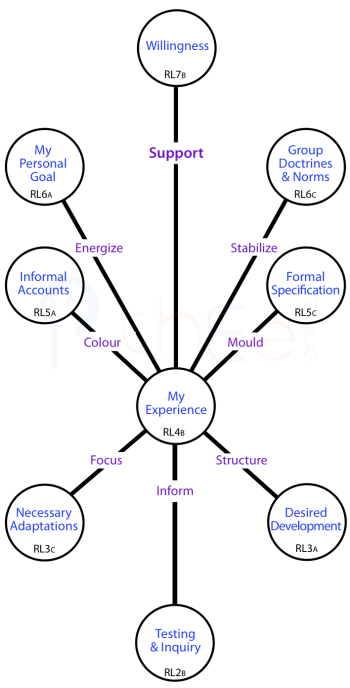Fluidity of Experience
Function of Experience

, simple and complex, are the evolutionary achievement of humankind. Each person plays their part in their own way as best they can given their circumstances. In creating and pursuing , we use our minds consciously and unconsciously.
The use of the mind entails implicit use (or misuse) of the Taxonomy as discovered and investigated on this website. Any part of the Taxonomy has to come into conscious awareness if it is to be used explicitly. For example, a may emerge as an or , which are forms or elements of .
However, itself is a vital mental tool in its own right. As developed during investigation of Endeavour-R, the function of is to serve as a personal reference gauge in creating and pursuing endeavours.
This function is essential in every sort of , that is to say anything and everything we each attempt. Inner like emotions, thoughts and intuitions provide signals, impetus and guidance so we can determine that the unfolding events are what we need, want and can accept.
Perhaps not surprisingly, is found at the heart of the Tree framework for . As revealed in the partial image from this Tree shown at right, are connected to every Centre but one.
All aspects of endeavour can be tricky, but seems to pose particularly intractable problems due to its fluidity.
Endless Flux
We suffer from an endless flow of of all sorts. This is surely partly due to the numerous endeavours, large and small, that we simultaneous juggle, some of which unavoidably interact or conflict.
However, the also seems caused by instabilities of our nervous system. Irrelevant stimuli provoke associations and memories and these reverberate. Ideally following a distraction, we reassert mental control and re-focus attention on the task at hand.![]() More ►
More ►
It seems that our experiential reference gauge is in danger of dysfunction through its intrinsic instability.
For an experiential gyroscope to guide effectively, it absolutely needs a degree of mental stability. It should therefore be no surprise that have evolved to help us master the turbulence of our .
Optimal Use of Experience
In other Primary Hierarchies within the Taxonomy, a set of 7 systems have been found within Level-6 that guide the use of elements of that Hierarchy for optimal effect e.g. within , there are Decision Systems; within , Ethical Choice Approaches. This set is referred to as a Principal Typology.
It is therefore proposed that within , there is a . Because we think of the mind and self as synonyms, i.e. we identify with our experiential flow, the name might have been «».
The Type in any Typology is primarily a methodical system. Here it provides a way to feel comfortably stable and able to «» naturally. The various methods may be referred to more abstractly as «approaches» or more personally as a «mentalities».
The deeper features of Principal Typologies are currently under investigation in the Architecture Room. In what follows, those principles will be applied.![]() Reminder of Principles
Reminder of Principles
- Clarify distinctions between mind, self, identity and more.
- Review the elements of experience.
- See the taxonomic path from to the .
Originally posted: 24-Sep-2014. Last updated 10-Dec-2014.